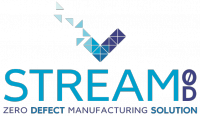Real-time simulation for in-line process control
Detailed simulations alone are not sufficient to create an effective process control: in order to obtain really accurate prediction models of the production process running in real-time, ROMs must be fed also with offline real data coming from the plant.
Checking a ROMs (Reduced Order Models) under certain conditions for an output forecast is something that can be done in real-time, but ROM based control systems are not so common and the strategy to build them might differ depending on the process characteristics. Why? The reason is that simulations do not cover all possible combinations of inputs, transient periods or sudden changes in input variables and conditions.
STREAM-0D project proposes a methodology to generate ROMs based on detailed simulations of the manufacturing process: The use of ROMs for process control purposes (namely accurate-prediction-making and the set-up of a methodology for the correction of potential deviations) is mandatory: with ROMs it is in fact possible to cover a wide scenario of variables; this cannot be done just with simulation.
More than a simulation
STREAM-0D proposal relies on inferring new output-data based on simulated data. With reference to the bearings’ pilot case, a simplified example scenario would consider a pair of predicted results from simulation:
- firstly, a simulation would run with a surface temperature of 65ºC and an input dimension of 30.00 mm, providing an output of 29.995 mm for the same dimension at 25ºC;
- secondly, a simulation would run at 67ºC for the same 30.00 mm dimension estimating an output of 29.993 mm at 25ºC;
For the non-available simulation of the same 30.00 mm dimension at 66ºC, a fairly good approximation would therefore be 29.994 mm.
Although this is a feasible way of creating a control model with detailed simulation data, it is still a blind model, since after a prediction is made, the assessment of the accuracy of the prediction from the model is still not checked. Therefore, in order to match simulations with real world, STREAM-0D team works in making the proposed offline control model able to learn from reality. To do so, once the simulation model has been built, it is fed offline with real data from the plant.
The goal is to reproduce the actual output from the real input data and thus validate or correct the data predicted by the ROM.
The principles underlying this process are the same as those used in data analytics or machine learning that is, inferring relationships between inputs and outputs based on experimental/real data. STREAM-0D approach is not a brute force attack from inputs to outputs, but a fine tune from predicted outputs to actual outputs, as most of the task is done beforehand through detailed simulations. This makes the learning process pretty faster and simpler so it can be implemented in the control model and run at real-time production pace.
Summarizing, STREAM-0D methodology comprises a detailed simulation of the manufacturing process, a control model based on the simulation data, and continuous refinement of the model through actual data, all done offline until the prediction confidence is good enough for handing over the control of the plant to the model.
At that stage, having a model capable of forecasting accurately the output will reduce dramatically the amount of rejected outputs.
—
This article was provided by ITAINNOVA, one of STREAM-0D’s project consortium partner. ITAINNOVA is the STREAM-0D project coordinator, and leading partner for the development of knowledge-based multi-physics simulation models and numerical simulation tasks. They also coordinate the pilot implementation of the product applications, leading one of them.
Follow STREAM-0D on:








